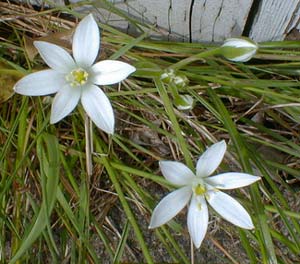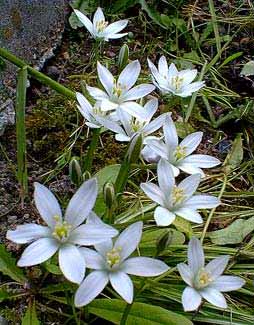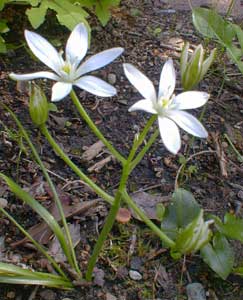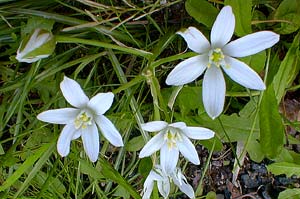 The Transient Blossoms of
The Transient Blossoms of
Sleepydick or Pyrenees'
Star of Bethlehem
"Flower, that I hold in my hand,
Waxen & white & unwoeful,
Perfect with your race's lovely perfection,
Pure as the dream of a child just descended from the heavens."
-Louis James Block
(1894-1927)
(1894-1927)
Sleepydick, Summer Snowflake, Starflower, Summer Snowflake, Summer Snowdrop, Grass Lily, Cape Lily, or the Pyrenees' Star of Bethlehem (Ornithogalum umbellatum), is a wildflower of Eurasia, North Africa, & the Mideast, today encountered fully naturalized throughout the eastern half of the United States plus the Pacific Northwest.
 Some states regard them as noxious weeds & wetlands invaders. We have patches of them in our gardens that we never planted, but which we've made no attempt to eradicate, as they're really quite lovely.
Some states regard them as noxious weeds & wetlands invaders. We have patches of them in our gardens that we never planted, but which we've made no attempt to eradicate, as they're really quite lovely.They require a "thermoperiodic cycle" to complete their life cycle do not naturalize where temperatures are very warm year-round, or where winters fall below five degrees Fahrenheight.
In temperate zones with summers in the 70s & winters in the upper 20s or low 30s suit them very, very well. They can be grown in colder zones (to USDA Zone 3) if they are heavily mulched for winter protection.
They tolerate summer droughtiness, but require a lot of moisture during winter & spring. They like woodland garden settings & can do well in full morning sun or day-long bright shade, though too much afternoon sun can weaken their appearance.
If intentionally planted, bulbs should be set out in Autumn, two or three inches apart, five inches deep. They naturalize in temperate gardens with great fascility, both from offsets thickening a single patch year by year, & from seeding, so that individual specimens appear from unexpected places, producing only crocus-like white-striped grass while the seed develops into a tunicated bulb. Lone self-seeded specimens pop up here & there, & one such is shown in the third photo (immediately below).
 An old patch can develop very dense turf, four inches to a half-foot tall in our garden, though in some places the grass is much taller. The grass appears in autumn & persists until the following late-summer. They can naturalize in thin grass or meadows, but should not be tried in lawns (like crocuses or glory-of-the-snow) because in most zones the lawn will require mowing before the Sleepdicks have had a chance to bloom, & to complete their lifecycle would have to go unmowed until after the seeds have ripened in summer.
An old patch can develop very dense turf, four inches to a half-foot tall in our garden, though in some places the grass is much taller. The grass appears in autumn & persists until the following late-summer. They can naturalize in thin grass or meadows, but should not be tried in lawns (like crocuses or glory-of-the-snow) because in most zones the lawn will require mowing before the Sleepdicks have had a chance to bloom, & to complete their lifecycle would have to go unmowed until after the seeds have ripened in summer.The two-inch star-flowers are sometimes shorter than the grass, sometimes taller, on forking leafless scapes most often up to eight inches, but a foot tall is possible. The blossoms appear in late April & throughout May. The individual blooms can be shortlived, but more will be opening for several weeks running. Flowers are followed in June & July by three-lobed capsules containing black seeds.
For the fastest propogation, division can be undertaken as often as every two years, in September or October to thin down an overly thick patch & to separate bulblets to plant elsewhere. Or to maximize seed-grown specimens, the seed-capsules should be harvested before they burst open in summer, & started in coldframes or pots.
Because it is toxic, Sleepydick is not much browsed by wild animals, & all parts of the plant should be regarded as poisonous to people & livestock. However, the bulbs are edible if they are either well-cooked, or dried & powdered. They are sometimes eaten raw, but the possible dangers make that less than wise. According to Stephen Facciola's Cornucopia: A Source Book of Edible Plants the blossoms have been used as an ingredient in baked bread & pastries.
Extracts are used by herbalists for treatment of fearfulness, suicidal depression, or grief, as well as for ulcers, flatulance, & such serious diseases as cancer. Efficacy in treating mental distress & serious physical diseases is of the highest level of dubiousness.
No modern herbalist with an IQ above sixty could seriously recommend Sleepdick medicinally, which means some would. Nevertheless, credible medical research does recognize mutagenic & antimutagenic properties to the toxic chemical components of the genus, worthy of further investigation of pharmaceutical-grade extracts for medicinal uses.
The name Star of Bethlehem is mainly in allusion to the six-pointed blooms, but may also have come about because it was used as a famine food by medieval pilgrims to the Holy Land & was to be found growing all around Bethelehem, perhaps planted there by the Christian pilgrims. It was known in Europe in an earlier time as Dog's Onion, but by the 15th Century it became associated with pilgrims & so came to be called Star-of-Bethlehem.
Its second most common name, Sleepydick or Sleepy Dick, is from not opening its buds until toward the end of morning. This habit also gave rise to the names Nap-at-Noon, Star at Noon, & Eleven O'Clock Ladies (or Lady Eleven O'Clock), or by the French equivalent, Bella d'onze heures or Dame d'onze heures.
By means of the doctrine of signatures, sleepydick gave rise to another piece of herblore. Because it didn't "wake up" properly in the morning, this was taken to be God's clue that this plant was recommendable as a treatment for sleep disorders, for disturbing nightmares, for fidgity restlessness, or for loss of feeling in limbs. It is useful for none of these things unless one imbibes a sufficient amount to die, which would pretty put an end to the fidgits.
Another folk name is Dove's Dung, Pigeon's Dung, or Sparrow's Dung, associating the plant with the biblical verse 2›Kings 6:25. This verse speaks of a type of wild onion that was not commonly eaten, but it became an expensive food item during a time of siege & famine.
It is thought that the specific plant named in Second Kings could well indeed have been Ornithogalum umbellatum. But early translations into English did not even know it was a plant being discussed, & so rendered it as a reference to people so hungry they would pay dearly for a meal of Dove's Dung.
 By a curious coincidence, which of course is no coincidence at all, the meaning of the ancient Greek name is preserved in the modern Scientific genus name which translates "Bird's Milk. And Star-of-Bethlehem is well known in several languages by names that translate Bird's Milk or Hen's Milk.
By a curious coincidence, which of course is no coincidence at all, the meaning of the ancient Greek name is preserved in the modern Scientific genus name which translates "Bird's Milk. And Star-of-Bethlehem is well known in several languages by names that translate Bird's Milk or Hen's Milk.The slangy term Bird's Milk is synonymous with "a wondrous thing," but originally alluded to an ancient belief that doves were of a single sex (females) & from the large breasts of the dove they were able to give milk, mammal-like, to their chicks.
The Dove was throughout the mid & near east believed once to have been a Star that descended to the world as a benefactor to humanity, so that both the Star & the Dove were entwined symbols of such goddesses as Ishtar, Aphrodite, & Cybele. When in Aristophanes' Lysistrata Pithetaerus says, "I will make you a king and will feed you on bird's milk & honey," he speaks of milk of a Goddess-bird that dwells upon Olympus.
Even the Virgin Mary is frequently portrayed, sans any evidence of her son, standing on the moon & encircled by stars, with dove over her head symbolic of the Divine Sophia or mother-principle of the Holy Trinity.
The folkname Chincherinchee is more appropriately for the South African species O. thyrsoides. White South Africans brought this name back to Europe as an "Englished" version of the African name tjenkenrientjee, & applied it to O. umbellatum & to other flowers within the Star-of-Bethlehem's genus. The name likely originated from the chaffing sound made by the much taller stems of O. thyrsoides.
The starry blooms close up entirely each evening. They are often only present for three or four days, but occasionally last longer than a week. In some years it seems they bloom so quickly I scarsely have time to spot them. When they appear, it us invariably in the wake of heavy warm spring rains that lasted about a week, culminating in sunny days.
Two main clumps of Sleepydicks, minimally tended in alley & along sidewalk on opposite sides of the property, are shown in the first & second photos above. These were in particularly harsh locations never whatered, & in such spots they do not bloom every year (unless I have missed them a couple of times because of their ephemeral nature), as their appearance depends on if the rain pattern excites them.
They do always provide long-lasting patches of deep green turf starting autumn & lasting through winter & spring, going dormant only in summer. The alley clump is especially large & turfy, & blooms best. The fact that this area gets very little water in summer while the bulbs are dormant serves them well.